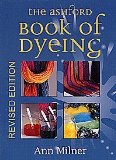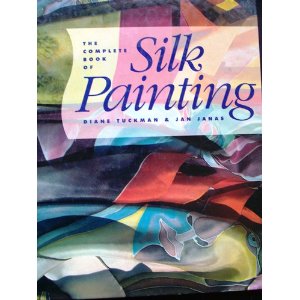Using Drimarene K dyes for painting silk scarves
Name: Alice
—ADVERTISEMENTS—
Learn silkpaintingfrom a master

DVD: Silk Painting
With Jill Kennedy

Silk Painting: The Artist's Guide to Gutta and Wax Resist Techniques
by Susan Moyer

Beginner's Guide to Silk Painting
by Mandy Southan

Ann Milner's book
The Ashford Book of Dyeing
The 7"x9.5" blue revised edition, dated 1998, is a very useful guide, but apparently there's a problem with a different edition. Look for ISBN 0-908704-88-7.

Linda Knutson's book
Synthetic Dyes for Natural Fibers

The Complete Book of Silk Painting
by Diane Tuckman
Country or region: Australia
Message: Hello Paula - I have already done a few searches but to no avail - the artist who taught me is not contactable at the moment and all I would like to know is, after mixing the Drimarine K dyes with metho and vinegar I am enquiring if I use vinegar or water to dilute for softer shades and how much as in quantity do I need to dip my scarves in before either steaming or microwaving - I have totally forgotten! I found your website very informative, hence, I am making contact...Thank you in advance for any help you can provide - Alice
Hi Alice,
Drimarene K dyes are fiber reactive dyes, like Procion H dyes and the Remazol or vinyl sulfone dyes. This means that there are two completely opposite ways to use them to dye or paint silk. One way is to combine the dyes in some way with a high-pH chemical, and the other is to combine them with a low-pH chemical. The way the dye reacts with the silk fiber to bond to it is completely different in these two methods.
If you use a low pH, that is, an acid such as vinegar, then the fiber reactive dye acts as an acid dye; it doesn't form the particularly strong chemical bonds that fiber reactive dyes can form to silk or cotton under high-pH conditions. You lose the special benefits of fiber reactive dye this way, primarily their extraordinary washfastness, which makes their color persist for years even with frequent launderings. However, you gain the advantage that the color yielded on silk by fiber reactive dyes are more likely to match the color-mixing chips in the catalogs and dye color charts, which are designed to show what colors those dye mixtures produce on cotton. There is less different between the colors yielded by pre-mixed cotton dyes on silk when vinegar is used instead of cotton. This advantage is not so important if you are using the pure unmixed colors of dye, which are most of what Batik Oetoro sells; the pure unmixed colors produce very nearly the same hue, though perhaps lighter or darker, no matter what the fiber, but premixed colors can produce quite unexpected results on different fibers. Vinegar (see my page, "Using vinegar or acetic acid for dyeing") is the most popular acid for hand-dyers to use as a dyeing acid, followed by citric acid; ammonium sulfate is also used and has some advantages. See "Fiber reactive dyes on protein fibers" for more information about using acid with fiber reactive dyes so that they function as acid dyes.
If you use a high pH, instead, then the fiber reactive dye gets to fulfill its ability to form a very strong and long-lasting chemical bond to the silk fiber. For room-temperature dyeing, a stronger base is used, such as soda ash or trisodium phosphate, but for silk that will be steamed it is usual to use baking soda, instead. (Baking soda, or sodium bicarbonate, dissolves to form a much lower pH at room temperature than soda ash, or sodium carbonate.) A marvelous property of baking soda is that it actually turns into soda ash when it is steamed or baked, so that the dye-fiber bond is not formed until steaming occurs. This feature provides much more control over how the dye performs when painted.
Of course, baking soda or soda ash are never used in combination with vinegar; the high-pH chemical reacts with the low-pH acid, and, if the quantities are balanced, will form a neutral salt solution that cannot fix dye to silk at all. You must choose either the high-pH chemical or the low-pH chemical, not both.
It seems that the method you are using (which is one I have not heard of before) involves mixing the Driamrene K dye with vinegar and alcohol in order to make your stock solutions of different colors for dye painting. This is not one of the more popular approaches to silk dyeing; most silk dye-painters either mix the dye with water and baking soda or soda ash, or presoak a scarf in diluted vinegar before applying the dye to the wet scarf. However, it seems clear to me that when you want to use a color that has less dye powder in it, in order to get a paler hue, you should use a solvent/acidifier mixture that is the same as what you originally used to dissolve or dilute the dyes, for the greatest possible consistency in how the different color mixtures of dyes act. I suppose that your "metho" is most likely a local abbreviation for methanol, also known as methylated spirits. You could mix methanol and vinegar in the ratio produced by the recipe you've been using to dilute your dyes, along with any thickener or other additives your recipe calls for aside from dye, and then use this mixture to dilute your dye colors. Use as little as one part of the usual ready-to-use dye mixture in nine parts of the extra diluant to make the palest pastels.
You will probably want to study different recipes used with Drimarene K and similar steam-set fiber reactive dyes for dye painting silk. They represent alternatives to the method your artist-teacher taught you. Start with Batik Oetoro's collection of recipes for Drimarene K dyes, which are compiled into one page on their website; scroll down for the recipe for the hand painting process for silk. (It contains a small amount of acetic acid just to aid in dissolving the thickener, but then fixes the silk with a combination of baking soda ash soda ash, presumably in a quantity more than large enough to neutralize the acetic acid.) There is also a recipe for using Drimafix to set the Drimarene K dye on silk or cotton, after the dye painting is completed; Drimafix is a chemical known as sodium silicate, or water glass; see my page, "Sodium silicate as a fixative for dyeing", for more information on using it.
Ann Milner's book, The Ashford Book of Dyeing, recommends using baking soda as the auxiliary when silk-painting with Drimarene K dyes, and includes a recipe for doing so.
Since Drimarene K dyes are very similar to other fiber reactive dyes that are used for silk painting, you can also follow their recipes. Procion H dyes in particular are similar to Drimarene K dyes in both chemical structure and in reaction requirements, though actually Drimarene K dyes can also react at lower temperatures, well below steaming. There are many links to recipes for painting silk with Procion H dyes toward the bottom of my "About Procion H Dyes" page. Among those links, a good choice to look at is the Internet Archive copy of Jacquard Products' instructions for using Procion H dyes for painting, printing, or stamping. PRO Chemical & Dye's recipe for Direct Application using PRO H-reactive Dyes (powder or liquid) [PDF] is another excellent source.
Remazol dyes are another type of fiber reactive dye that can be used very similarly to Drimarene K dyes; their chemistry is not quite as close as that of Procion H dye, but their minimum temperature requirement for the high-pH method is closer. PRO Chemical & Dye, in the US, sells Remazol-type dyes as their "Liquid Reactive" dyes; see their instruction sheet for "Direct Application using Liquid Reactive Dyes". [PDF] Note that four different fixative recipes are given there, all of which are suitable for fixing the silk paintings after they dry. None of the recipes call for methanol, only water, urea, detergent, and water softener, in addition to the fixative you select. Another source for silk-painting recipes using Remazol dyes is Jacquard Products, which sells their Remazol-type dyes as Vinyl Sulphon; these recipes should also be equally usable for Drimarene K dyes, which are similar in their temperature and pH requirements. See their recipe for Concentrated Vinyl Sulphon dyes [PDF file], as well as their shade mixing chart [PDF].
You can see other sources for the method of microwave-steaming silk, in which you presoak the fabric in vinegar or vinegar-and-water before painting the dye on. With this technique, there is no need to add vinegar (or high-pH chemicals) to the dye paint. The vinegar in the fabric presoak is sufficient; it should not be allowed to dry, since the acetic acid in vinegar will eventually evaporate. Some recipes call for using straight distilled vinegar, the ordinary type that is 5% acetic acid; others call for diluting the vinegar with an equal quantity of water, or with twice as much water as vinegar. All of these will work, as long as the dye gets plenty of time to react with the silk at steaming-hot temperatures. Here is a link to Dharma Trading Company's simple recipe for "Tie-Dyeing Silk in a Microwave with Vinegar". Note the use of the plastic bag for steaming in the microwave: never allow silk or other fabric to be dried by the action of the microwave, which can happen if you don't seal the steam in with plastic. Microwaving dry fabric will result in fires, ruining the fabric, and doesn't work to set dye. Watch the bags as they cook in the microwave, ready to quickly turn off the microwave oven when the bags inflate with steam, so that they do not burst.
(Please help support this web site. Thank you.)
(Please help support this web site. Thank you.)
Posted: Friday - September 07, 2012 at 08:40 AM
Follow this blog on twitter here.
Quick Links
- All About Dyes & Dyeing Top -
- Top of this blog -
- FAQ -
- The Dye Forum -
- How to Tie Dye - How to Batik -
- Books - Toys - Plants -
- Top of this blog -
- FAQ -
- The Dye Forum -
- How to Tie Dye - How to Batik -
- Books - Toys - Plants -
More in this category:
- -
Statistics
Total entries in this blog:
Total entries in this category:
Published On: Sep 07, 2012 09:28 AM
Total entries in this category:
Published On: Sep 07, 2012 09:28 AM